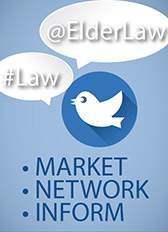

“What is Twitter?” asked Lance, sitting at the long, highly polished walnut table in the conference room of L & L Law Firm. Linda joined him as he continued. “I looked up the word and it means ‘to talk in a quick and informal way about unimportant things.’ That doesn’t sound right for a law firm.”
“It started out that way in 2006,” said Linda, “when it was developed and used by a few college friends on the East Coast to keep in touch. Now the creators see it as an informational network more than a social network. And I think it’s right for law firms, including ours.”
Linda is correct. L & L Law can use Twitter to market their practice, network with other lawyers, and to establish authority in their area of expertise, elder law.
From its early days as way for friends to stay in touch, Twitter has grown to be both a networking tool and news source. Twitter’s mission statement is: “To give everyone the power to create and share ideas and information instantly, without barriers.” The 302M active monthly users that send out 500M tweets a day agree with that statement.
For those few who don’t know, Twitter is a network of real-time posts limited to 140 characters or less. Its posts are called Tweets, which can contain photos, videos, links, and text. As with all things, there is a vocabulary for Twitter, which can be found at the Twitter Glossary.
To set it up, go to Twitter.com and follow the directions. Start with a name, which is preceded with the @sign. You can use your name, your law firm name, or a category such as @Elderlaw or @ElderLawlawyer. If the name isn’t available, keep trying until you find one that suits. Then add a complete profile—the one you uploaded on our SBM Member Directory will work. Don’t forget your picture.
The whole idea of Twitter is to connect with people with similar interests. To find them you can go to the leaders in your area of practice, click on their Twitter account to discover whom they follow. Follow the ones that interest you, they will follow you back and, ipso facto, you’re active on Twitter. It is also possible to use the (#) hashtag symbol followed by a word such as #law. Write that in the search feature on your Twitter page—it’s up in the right-hand corner—and tweets from people using #law will pop up.
Put a # followed by a descriptive word anywhere in your tweet and it will appear on that list of others who hashtagged the word. Add a Tweet Button (the Twitter website tells you how) to your website and your profile. Soon fellow Tweeters will find and follow you.
The experts recommend that of ten tweets, five should post links to news articles, blogs, or newsletters, three are interactions with other twitter users, one your own promotional materials, and one your personal interests. It’s very possible someone on Twitter likes to sail or knit or attend the opera and would like to start a conversation. Remember that anything you say is public and can’t be erased. And you know to never give legal advice or answer complicated legal questions—stick with news and posts in your area of practice.
Twitter, like the law, has best practices.
- Upload a complete profile with your picture
- Choose Twitter friends carefully—it’s a network not a popularity contest
- Leave 20 to 40 characters at the end of your tweet for a re-tweet by a reader
- Thank followers for the re-tweet or the follow
- Remember it’s not about you, it’s about information, limit your boasts
Twitter can be a great resource of information, a place for you to network with other lawyers in your area of expertise or your city, a way to keep in touch with clients, and develop your personal brand. Linda and Lance will give it a go, and you can too.
 Roberta Gubbins has served as the editor of the Ingham County Legal News. Since leaving the paper, she provides services as a ghostwriter editing articles, blogs, and e-blasts for lawyers and law firms. She is the editor of Briefs, the Ingham County Bar Association e-newsletter, and The Mentor, SBM Master Lawyers Section Newsletter.
Roberta Gubbins has served as the editor of the Ingham County Legal News. Since leaving the paper, she provides services as a ghostwriter editing articles, blogs, and e-blasts for lawyers and law firms. She is the editor of Briefs, the Ingham County Bar Association e-newsletter, and The Mentor, SBM Master Lawyers Section Newsletter.
Read More Clear & Convincing Articles